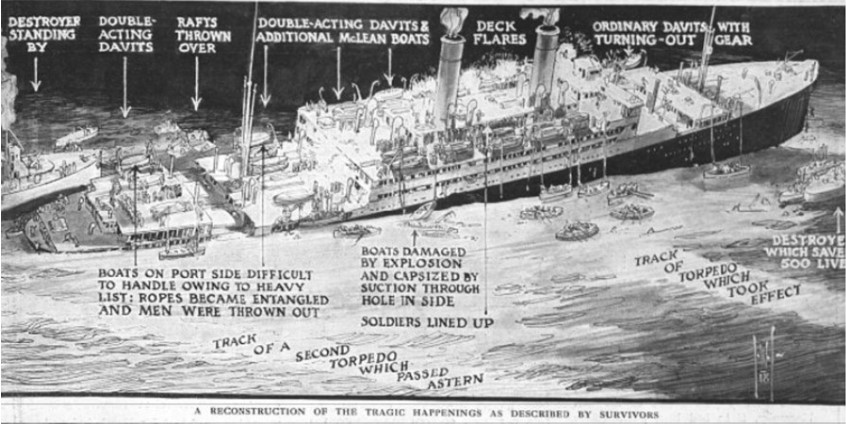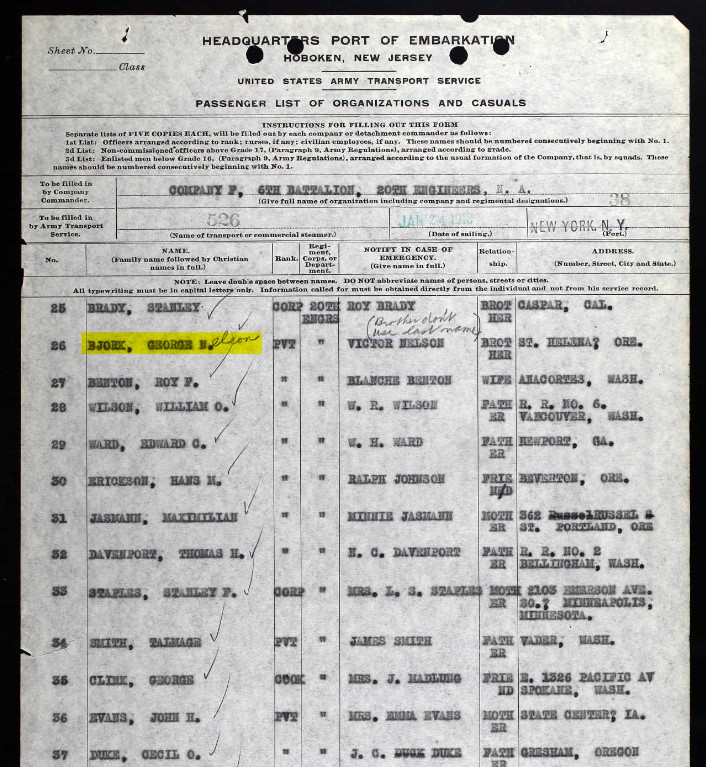At the moment I have limited my research database to contain those Swedish born soldiers who fought and fell in the Great War and are buried or commemorated on memorials along the Western Front in Belgium and France.
I will now extend the research to also connect those Swedish born soldiers who fought and fell in the war and are buried in other countries.
In this small article I will mention those soldiers who were involved in the sinking of SS Tuscania on February 5th, 1918.

On 24 January 1918, Tuscania departed Hoboken, New Jersey, with 384 crew members and 2,013 United States Army personnel aboard. On the morning of 5 February 1918, she turned south for the North Channel en route Liverpool. The German submarine UB-77 sighted Tuscania′s convoy during the day, and stalked it until early evening. Under the cover of darkness around 6:40 pm, the submarine’s commanding officer, Korvettenkapitän Wilhelm Meyer, ordered two torpedoes fired at Tuscania. The second of these struck home, sending her to the bottom of the Irish Sea within about four hours. Tuscania sank nearly three years to the day after her maiden voyage as a passenger liner. About 210 of the troops and crew were lost, while many others were rescued by the Royal Navy destroyers Mosquito and Pigeon.Some of the U.S. Troops were rescued by an Irish fishing boat as well. (from Wikipedia)

Onboard the ship, on his way to France, to join the war with the American Expeditionary Forces (AEF), were George Nelson Bjork (George Björk). He was born in Bäcke parish in Västra Götaland county in Sweden, June 13th, 1892.

The family left Sweden for Norway in March 5th, 1897, and stayed there at least until his father, the soldier and later on the corporal, August Björk, died in Norway in 1908. His father is also mentioned once as August Nilsson Björk, and that may be the reason that George is called George Nelson Bjork.
George was drafted for the American Army on June 5th, 1917, and left New York on January 24th, 1918, together with his unit, the 6th Battalion in the 20th Engineers, AEF. In the passenger list his nine years older brother, Victor Nelson, but also a note that Victor doesn’t have Nelson as his real surname. It should probably have been Bjork as well.

Around 11 days later the ship SS Tuscania is hit by torpedoes from a German submarine.
The wreck of Tuscania lies today between Scotland’s Islay and Northern Ireland′s Rathlin Island, about 7 nautical miles (13 km) north of Rathlin lighthouse, at roughly 55°22′N 6°13′W at a depth of 100 m (330 ft). (Wikipedia)
George died during the attack, but his body was found and initially buried at Kilnaughton Cemetery, Port Ellen Islay Argyll, Scotland. It was later moved to the Arlington American cemetery in Virginia, USA. His mother, Sofie Bjork (Sofia Pettersdotter Björk) was informed, as mention Next of Kin on his casualty card.
Sofia lived with her son Anton in Montana at the time of George’s death, and she applied for Naturalisation in 1912, after have emigrated from Norway via England and Canada, before ending up in the USA.


Another Swede survived
Onboard the ship was also the Swedish born soldier Carl M Anderson (Karl Martin Andersson). He survived the sinking of the ship and was later on engaged in the war in France, but later died from disease (Tuberculosis Pulmonary) in a field hospital in Le Mans, France, on April 15th, 1919.
He was later moved to the American Arlington Cemetery in Virginia.

Carl was born on January 15th, 1894, in Asker parish, Örebro, Sweden. He was raised by his parents, his mother Hilma Carolina Nilsson and his father Per Adolf Andersson. His mother died already in 1897, and his father was the remarried to Alma Maria Nilsson.
It has been hard to find the correct information about Carl M Anderson, but I know that he lived in Barren, Wisconsin, when he was drafted to the American Army on June 5th, 1917.
His Aunt, Mrs Ernest Nelson (her husband) is mentioned on his casualty card, and he was working with his uncle, Ernest Nelson. His family may have stayed in Sweden.



I will put in Carl into my research as he participated on the battlefield in France together with the American units, but I will put George into a side project as he never reached the battlefield in France. As for now I will keep those separated.
Although my main purpose with my research is to commemorate all the Swedish born soldiers who joined the different armies in different countries after they have emigrated from Sweden, to fight in WW1, so I might change the focus to include all of them, even if they never reached the battlefields.
That will also include those who became ill and died of disease in England, before they went over to France, and are buried in England.
They did their service, and for that they will be remembered.
Links:
